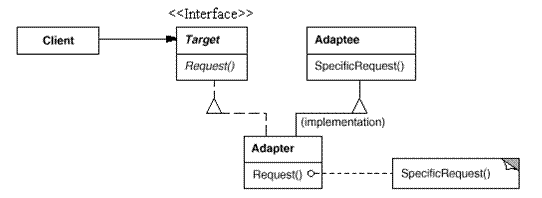一、定义
适配器模式:属于结构型模式,其主要作用是将一个类的接口转换成客户希望的另外一个接口。适配器模式使得原本由于接口不兼容而不能一起工作的那些类可以一起工作。
The Adapter Pattern converts the interface of a class into another interface the clients expect. Adapater lets classes work together that couldn’t otherwise because of incompatible interfaces.
二、适用情况
-
想使用一个已经存在的类,而它的接口不符合需求。
-
想创建一个可以复用的类,该类可以与其他不相关的类或不可预见的类(即那些接口可能不一定兼容的类)协同工作。
-
想使用一些已经存在的子类,但是不可能对每一个都进行子类化以匹配它们的接口。对象适配器可以适配它的父类接口。(仅适用于对象Adapter)。
三、实现方式
1.类适配器


2.对象适配器

其中:
• Target
— 定义Client使用的与特定领域相关的接口。
• Client
— 与符合Target接口的对象协同。
• Adaptee
— 定义一个已经存在的接口,这个接口需要适配。
• Adapter
— 对Adaptee的接口与Target接口进行适配
四、代码实现
1.类适配器
package com.visionsky.DesignPattern;
interface Target {
void Request();
}
class Adaptee {
void SpecificRequst() {
System.out.println("Adaptee's SpecificRequst");
}
}
class Adapter extends Adaptee implements Target
{
@Override
public void Request() {
System.out.println("Adapter's Request");
super.SpecificRequst();
}
}
public class AdapterDemo {
/**
* @param args
*/
public static void main(String[] args) {
// TODO Auto-generated method stub
Target t=new Adapter();
t.Request();
}
}
2.对象适配器
package com.visionsky.DesignPattern;
interface Target {
void Request();
}
class Adaptee {
void SpecificRequst() {
System.out.println("Adaptee's SpecificRequst");
}
}
class Adapter implements Target
{
private Adaptee adaptee;
public Adapter()
{
this.adaptee=new Adaptee();
}
@Override
public void Request() {
System.out.println("Adapter's Request");
adaptee.SpecificRequst();
}
}
public class AdapterDemo {
/**
* @param args
*/
public static void main(String[] args) {
// TODO Auto-generated method stub
Target t=new Adapter();
t.Request();
}
}
五、生活中例子
在生活中最简单的例子就是电源适配器,如手机适配器,家用电源是220V的,但是,对于手机来说,根本大不了这么多,所以,在这种情况下,需要电源适配器来提供适合手机的电压。
package com.visionsky.DesignPattern;
public class AdaterDemoInLife {
/**
* @param args
*/
public static void main(String[] args) {
// TODO Auto-generated method stub
MobilePowerAdapter mpa=new MobilePowerAdapter();
mpa.GetPower10V();
}
}
interface ITarget {
int GetPower10V();
}
class Power {
int GetPower220V() {
return 220;
}
}
class MobilePowerAdapter implements ITarget
{
private Power power;
public MobilePowerAdapter( ) {
this.power = new Power();
}
@Override
public int GetPower10V() {
// TODO Auto-generated method stub
power.GetPower220V();
//将220v转变成10v,具体做法就不写了, 大家明白就行
return 10;
}
}
六、经验总结
适配器模式不适合在详细设计阶段使用,它是一种补偿模式,可以在系统后期的维护和修改中使用。






















 1110
1110

 被折叠的 条评论
为什么被折叠?
被折叠的 条评论
为什么被折叠?








